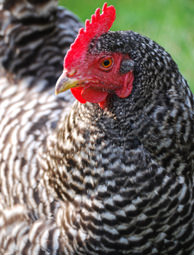Vermont Plays Matchmaker for Local Food IndustryBuyers and sellers “speed date” at the 2009 Local Food Matchmaker.Buyers and sellers “speed date” at the 2009 Local Food Matchmaker.local food, vermont matchmaker, agricultureBuyers and sellers “speed date” at the 2009 Local Food Matchmaker.By Rachael Brugger, Associate Web EditorNovember 13, 2009news, ufnews, rbrugger

Courtesy Vermont Cheese Council/ Calley Hastings
Robert Krupp from Granny Blossom’s Specialty Foods shares his product with potential buyers. Following the “speed-dating” model, Vermont’s local food producers and buyers got to know each other in short, 10-minute sessions. |
Local food exchange is all about relationships. Famers offer their products to local businesses and local businesses hire farmers to grow their food. The challenge lies, however, in getting these two willing groups to intersect.
To facilitate the “hooking up” of producers and buyers, the Vermont Agency of Agriculture, Food and Markets adopted the speed-dating model and hosted the second Local Foods Matchmaker.
Participants from Vermont and neighboring New Hampshire and Massachusetts converged for a series of 10-minute sessions in which buyers sat down with sellers to hear a product pitch. If a connection was made, the two made plans to follow up on the offer.
For the 2009 event, 40 buyers and 60 sellers tested their “dating prowess” at the Juniper Hill Inn in Windsor, Vt. According to the organizers, it was a fun way to engage buyers and sellers on the local level and encouraged growth in Vermont’s local-food movement.
“The bigger purpose [of the Matchmaker] is to explore the place local foods can have in retail and food-service settings and to see what we can do to ensure that communications between producers and these types of commercial businesses run smoothly,” said Diane Bothfeld, Vermont’s deputy secretary of agriculture.
The agency co-sponsored the event with Vermont Fresh Network, Vermont Grocers’ Association, Vermont Specialty Foods Association, Healthcare Without Harm and Vermont Hospitality Council.
Diane Imrie, director of nutrition services at Fletcher Allen Health Care in Burlington, Vt., represented the hospital at this year’s event as a buyer.
“Almost four years ago, we signed a ‘Healthy Food in Health Care’ pledge that includes working directly with local farmers,” she said. “We have quite a few relationships with local farmers, but there are lots of foods that we haven’t found locally yet.”
At the Matchmaker, Imrie discovered a new local yogurt product and networked with Vermont farmers who could provide her with locally grown tomatoes.
Doug Davis, the director of food services at Burlington Local Schools, also in Burlington, Vt., was able to add the Vermont hydroponic tomato to the school’s menu as a result of this year’s Matchmaker and discuss nontraditional methods of getting food into the schools. The school system uses about $50,000 of local produce every year, up from just $300 a few years ago, Davis said.
“We’re trying to provide better meals for our kids while including the local community and local vendors,” Davis continued. “It’s important that we take the money we have and put it back into our community.”
On the sellers’ side, Harrison Lebowitz from Snow Farm Vineyard attended the event to introduce his vineyard, which he claimed is the oldest commercial vineyard and winery in Vermont.
“Locals want to support local businesses and visitors want to try everything local,” he said. “Why come to Vermont to drink a California wine?”
Each participant said they would attend future Matchmakers.
This was the Agency of Agriculture’s second matchmaking event.
“We used the lessons learned from last year to provide extra information through handouts and workshops to help buyers and sellers communicate with each other,” said Helen Labun Jordan, food policy administrator for the Vermont Agency of Agriculture. “Some people are picking up conversations they started a year ago, so it’s not unfamiliar territory any more.”
Play Local Foods Matchmaker
Organizations in other parts of the country can set up similar events in their area. In 2008, the first year of the Vermont Local Foods Matchmaker, organizers took a basic approach that required a simple venue and a minimal advertising budget.
For the venue, they set up small tables, to fit about four people each, where buyers and sellers could meet. They also allowed extra rooms where participants could meet and mingle while not in sessions.
The Vermont organizers also did not charge for the event, so they had to keep their marketing costs low. They sent out information about the event through e-mails, newsletters and calendars, as well as met with state agriculture organizations.
To make the Vermont event a success, the organizers focused on the buyer-seller relationship. They secured buyers who were interested in participating with enough time to woo interested sellers.
“The real success of the Matchmaker is in the energy generated between buyers and sellers – it’s a chance for participants to get out and meet new people, explore new products, and get excited about the diversity of the local food system,” Jordan said.













